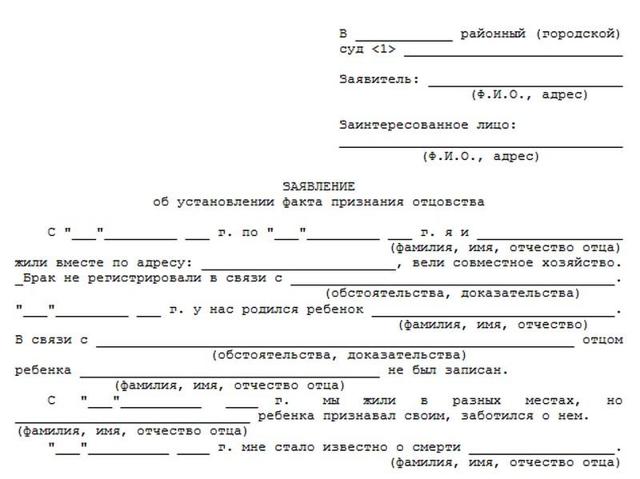If the parents were registered at the time of the child’s birth, the spouse automatically becomes the father. A mother who gives birth out of wedlock will, if necessary, be forced to officially establish paternity.
Proving this circumstance depends on various situations and is carried out in several ways. This article will tell you what the difference is between establishing paternity and recognizing paternity.
Establishing paternity
 There are different ways to carry out this procedure. The simplest of them is voluntary establishment of paternity. To do this, the mother and father submit a joint application to the registry office where the child was registered.
There are different ways to carry out this procedure. The simplest of them is voluntary establishment of paternity. To do this, the mother and father submit a joint application to the registry office where the child was registered.
After some time, the parents will be issued a new birth certificate, with changed information about the father. Court proceedings are not required for voluntary establishment of paternity.
Most often, paternity is established for the purpose of obtaining child support. The procedure may also be necessary if the guardianship authorities do not allow the father to raise the child after the mother died, went missing or was declared incompetent.
Until there is documentary evidence that the citizen is indeed the father, the guardianship authorities do not have the right to give him a son or daughter.
To begin the procedure for establishing paternity, it is necessary to file a claim with the judicial authorities at the place of residence, this can be done by the following persons:

- mother;
- father;
- a child over 18 years of age;
- guardian of a minor;
- official representative of the plaintiff under a notarized power of attorney;
- guardianship worker.
The application is accompanied by a package of documents and evidence of the blood relationship between the child and the defendant. 5-7 days after filing the application, a hearing date is set. At the court hearing, the evidence presented by the plaintiff is considered, the testimony of witnesses is heard, after which a decision is made on the case.
If the plaintiff’s demands have been satisfied and paternity has been established, it is necessary to submit an application to the registry office within three days to change the entry about the father on the birth certificate.
Establishing the fact of recognition of paternity: what is it?
It is done if the child’s father has already died, and the parents were not married, but during his lifetime the man recognized his son or daughter. This procedure is regulated by Article 50 of the RF IC and the Code of Civil Procedure.
There are often situations when a man did not intend to die, he was ready to officially recognize the child, give him his last and patronymic name, but simply did not have time to do this or died before the baby was born.
Establishing this fact is also necessary to respect the legal rights of the child, while he is guaranteed to receive:

You can start the procedure only if certain conditions are met:
- the parents were not registered when the baby was born;
- during life, the man recognized his blood relationship with the child;
- the father is not missing, the fact of his death has been definitely established.
There is no statute of limitations for the case. Since the plaintiff acts in court in the interests of the child, he does not have to pay the state fee.
Statement of claim
- The territorial jurisdiction of the cases is as follows: the applicant has the right to appeal to any court of general jurisdiction - city, district or regional.
- The court provides a sample application that can be filled out by the mother, the child himself upon reaching the age of majority, the guardian or trustee of the incapacitated person.
- The application must indicate the following information:
- last name, first name, patronymic of the person submitting the application.
- the surname and initials of the putative father.
- name and address information of the judicial authority where the claim is filed.
- information about the child - first name, last name, date of birth, for what reason he was not recognized as the father.
- the purpose pursued by the plaintiff.
- all materials collected as evidence of the relationship between the child and the alleged father.
- list of additional documents - plaintiff’s passport, child’s birth certificate, father’s death certificate, etc.
A sample application for establishing paternity recognition can be downloaded here.
Procedure for considering the case
If no problems or property disputes arise during the process, and the evidence presented by the plaintiff is quite convincing, the case will be resolved quite quickly in a special proceeding; one court hearing will be enough.

In this case, it is not enough for the plaintiff to simply file a statement of claim; the parties to the conflict will have to go through the procedure of legal proceedings. The proceedings will be more complex and may last 2-3 months. The procedure in this case changes slightly.
Another lawsuit is drawn up, where the child is designated as one of the possible heirs. This paper is presented to the relatives of the deceased, who also claim the inheritance. Here, the totality of evidence collected by the plaintiff is of particular importance - the more there is, the higher the likelihood of a positive court decision in favor of the child.
A difficult point in collecting evidence is the search for facts indicating that the father recognized his child during his lifetime. Even if the evidence is lost, it would be useful to mention it at the court hearing.
The following is used as evidence:

- any documents, objects or testimony confirming that the man lived for some time with the child’s mother, ran a joint household with her, participated in the upbringing and maintenance of his son or daughter;
- paper and email letters, SMS messages where the father mentions the child;
- photos and videos showing father and child together;
- results of medical examinations confirming that, based on blood type or Rh factor, the child and the intended father may be close relatives.
Is it possible to use DNA testing?
As is known, it is impossible to carry out a DNA test posthumously. However, the plaintiff can agree with one of the close relatives of the deceased to participate in the examination. Compared to the biological material of the father, the percentage of relatedness in this case will be lower (not 99.9%).

Carrying out a DNA test usually causes the legal process to drag on for a long time, this happens for the following reasons:
We must not forget that DNA testing is done only voluntarily; it is impossible to force a person to undergo it.
The court's decision
If the court makes a positive decision and the fact of paternity is recognized, the deceased person is recognized as the biological father of the child, this gives him certain rights:

- bear the father's surname and patronymic;
- inherit property;
- receive a survivor's pension or financial compensation if the father's death was violent.
The court decision comes into force one month after its adoption. During this time, those who disagree with the court's decision have the right to appeal to higher authorities.
After 30 days, the plaintiff must contact the registry office, where the necessary changes will be made to the documents and the child will receive a new birth certificate.
What is the difference?
The main difference between establishing the fact of paternity and recognizing paternity is the following:
- paternity is established when the child’s father is alive, but refuses to recognize, educate and support him;
- establishing the fact of recognition of paternity implies that the father, who has already died, knew about the child during his lifetime, but for some reason was unable or did not have time to officially recognize his paternity.
In addition, cases of establishing paternity are considered in lawsuit proceedings, that is, at the request of the interested person.
In such cases, property or material claims of the parties against each other almost always arise. In legal practice, such situations are called disputes about the law.
Establishing the fact of recognition of paternity is considered in a special proceeding, that is, according to a simplified scheme, if there is no dispute in the case about the right, material claims of one party to the other.
Both procedures described in the article are quite complex. To avoid problems when considering a case in court, it is advisable to hire a competent lawyer. He will tell you what documents and evidence need to be collected, help you correctly draw up a statement of claim, and will handle the case until the end of the trial.
—>
Establishment of paternity after the death of the father, acceptance of the fact of paternity and judicial practice
A child whose parents are not married, officially registered with the registry office, has the same rights as those born after the marriage procedure.
They most often have a blank in the “father” column on the birth certificate - mothers in this case register their children without the participation of the second parent.
But sometimes there are situations when it is necessary to establish paternity, and by that time the parent is no longer alive.
Is this problem being solved? Is it possible and how to prove paternity outside of marriage after the death of the father? Family ties in this case are established only in court. Only a person vested with the appropriate rights by law can submit an application. Let's look at how to do this according to all the rules.
Dear readers! Our articles talk about typical ways to resolve legal issues, but each case is unique.
If you want to find out how to solve your particular problem, please use the online consultant form on the right or call +7 (499) 450-39-61. It's fast and free!
The procedure for establishing paternity after the death of the father: basic provisions
The procedure carried out by a judicial authority in order to establish a possible relationship between a child and a deceased man is called “recognition of paternity.”
The procedure for filing a claim is influenced primarily by the circumstances of the case. Particularly significant ones include:
- Before his death, the citizen was going to recognize the child, but measures on this matter were not taken due to the death that occurred.
- During his lifetime, the man was not going to recognize the baby, or even denied their relationship.
 These factors will determine how you file your claim. If the procedure for determining kinship was a planned event, then the recognition of paternity after the death of the father will be carried out within the framework of simplified proceedings.
These factors will determine how you file your claim. If the procedure for determining kinship was a planned event, then the recognition of paternity after the death of the father will be carried out within the framework of simplified proceedings.
- Other interested citizens will not take part in it; the main thing is to establish a legally significant circumstance, that is, the relationship between the deceased and his child born out of wedlock.
- If the deceased citizen denied the possibility of a family connection, legal proceedings will be conducted on a general basis.
- Accordingly, other citizens who are interested to one degree or another in the decision taken will take part in it; it will be necessary to present evidence and conduct a DNA examination.
- This is necessary because most often it arises in connection with certain rights that need to be restored to the child - for example, the right to inherit part of the deceased’s property
Reasons for citizens' appeals
A connection with a deceased parent can be proven for both a minor child and a person over 18 years of age.
The need arises in the following cases:
- For a minor, recognition of kinship means that he will be able to receive funds paid by the state in the event of the loss of a breadwinner . Also, a child may qualify for compensation if a parent was killed or died due to the criminal actions of other people.
- Inheritance is the main reason why an adult child may require the establishment of family ties.
Establishing paternity if the father has died gives the child the opportunity to fully exercise his rights, including receiving some financial resources for his own support.
Legislative basis
 The main provision in this situation is stated in Article 50 of the Family Code.
The main provision in this situation is stated in Article 50 of the Family Code.- Its essence is that children born out of wedlock can establish kinship with a deceased parent in accordance with civil procedural legislation.
- Establishing the fact of paternity of a deceased citizen is regulated by the following legislative acts in force on the territory of the Russian Federation:
- Family Code.
- Code of Civil Procedure.
- Methodological guidelines of the Ministry of Health No. 98/253, No. 2001/4.
- “The procedure for organizing and conducting forensic medical examinations in state expert institutions”, adopted within the framework of the order of the Ministry of Health and Social Development.
- Constitution.
- Federal Law “On State Forensic Expert Activities”.
- Other regulatory legal acts.
Establishing paternity if the father has died is important not only from a material point of view, but also from a moral satisfaction. Especially in cases where the citizen was going to take all the necessary measures himself, but did not have time to do it.
Establishing the fact of paternity after death in court
So, it is possible to establish posthumous paternity. Judicial practice shows that in most cases a positive decision is made regarding such claims.
When can the procedure be started?
If the father died, how to establish paternity? The first thing you need to know is when exactly to file a lawsuit.
The Code of Civil Procedure of the Russian Federation states that in this case you can apply for restoration of rights at any time. This provision is enshrined in Articles 264-266.
Important! The more thoroughly the preparation stage is worked out, the more likely it is that paternity will be recognized as soon as possible after the death of the father. Judicial practice shows that sometimes such cases are considered for quite a long time.
Persons entitled to file a claim
Not every citizen is able to file a statement of claim, on the basis of which a trial will be launched. By law, only a limited number of people have this opportunity.
 The case can be initiated by:
The case can be initiated by:
- Mother.
- The legal representative of the minor, appointed in accordance with current legislation.
- The head of the institution where the child is located. This happens if the mother is dead or deprived of parental rights.
- Upon reaching adulthood, the offspring himself is an adult.
Applications from other citizens will not be considered.
Statute of limitations

- These, fortunately, do not include the establishment of the fact and recognition of paternity after the death of the father.
- Judicial practice shows that a claim is not always filed immediately after registering a death.
- This is done most often when any conflict situations arise, for example, division of property.
What needs to be proven
Since the father himself, for obvious reasons, cannot appear at the meeting. The child (or his representative) has the responsibility to provide the court with evidence of certain facts. These include:
- Birth of a child. This is easy to do - just show your birth certificate, as well as your passport (if available).
- The death of a parent. The court will require a document confirming the occurrence of this case - a certificate from the morgue or a death certificate. If the plaintiff’s document is missing, it is necessary to invite a person who has access to it.
- Lack of registered marital relations between parents.
- The fact that a citizen recognizes paternity during his lifetime.
The hardest part is finding evidence to support the last point. However, the court will take into account correspondence (including electronic), photos and videos of the father and baby (joint), documents, and witness statements.
Important! The court will not consider as evidence financial assistance provided by a citizen to a mother or child.
Documents required to file a claim
How to prove paternity if the father is dead? First, collect a set of papers:
 certificate of absence of marital relations between mother and father;
certificate of absence of marital relations between mother and father;- confirmation of joint residence with housing and communal services;
- a copy of the paper confirming the death of the parent;
- birth certificate – original and photocopy;
- a receipt confirming payment of the state duty.
Drawing up an application
The most important document in this case is the statement of claim. It states:
- address of the judicial authority;
- information about the applicant;
- meta residence address;
- the basis for the requirements;
- list of attached papers.
Subtleties when compiling manually
The application can be drawn up in free form. But in this case, it is necessary to include in it all the information prescribed by law. However, it will be more convenient to use an existing sample - this way you can save time, because you just need to fill in the empty fields.

You can find a sample application here. You are also required to provide a form in court, or show an information stand where there is a corresponding sample.
Download sample.
If paternity was recognized by the deceased father
How to establish paternity after the death of a father? In the case where a citizen simply did not have time to recognize the child and this fact can be proven, the proceedings in the case are significantly simplified.
Stakeholder involvement does not occur in this situation.
DNA examination
 If you are interested in how to establish paternity after the father’s death in court, you should remember that the most important evidence of kinship is DNA testing.
If you are interested in how to establish paternity after the father’s death in court, you should remember that the most important evidence of kinship is DNA testing.- Stock up on biological material in advance, for example, take it from the morgue.
- It is allowed to use the DNA of relatives of the deceased.
Important! The party requesting the examination will pay the costs.
Conclusion
Acknowledgment of paternity is the most important procedure. And although it is most often carried out to obtain material benefits, the very fact of official recognition will also bring moral satisfaction.
To make the proceedings go faster, seek help from qualified lawyers who will help in collecting evidence.
Didn't find the answer to your question?
Find out how to solve exactly your problem - call right now:
+7 (499) 450-39-61
It's fast and free!
Establishing the fact of recognition of paternity
In judicial practice, the procedure for establishing paternity is quite common.
If during a man’s lifetime it does not present any particular difficulties, then in the event of his death it can turn out to be a very difficult undertaking. To restore justice at the legislative level, a clear scheme was built. Let's talk about it further.
What is establishing the fact of recognition of paternity?
If we turn to terminology, paternity is established in court only if the child’s father is alive. If he died, such a procedure will be called establishing the fact of recognition of paternity. It is necessary in order to confirm blood ties between the child and the deceased parent, if the mother was not officially married to him.
This process is regulated by the Constitution of the Russian Federation, the Investigative Committee of the Russian Federation, the Civil Procedure Code, orders of the Ministry of Health regarding the conduct of forensic medical examinations and other acts.
Establishing the fact of recognition of paternity is a very important procedure on which the future future of the child may depend.
As a rule, it is used if a man was going to recognize his son or daughter officially, but due to a tragic coincidence, did not have time to do so.
It is also possible that a man died before the birth of the child or refused to recognize him. These provisions are spelled out in Art. 50 IC RF.
The procedure can be carried out for several main reasons. This is necessary to obtain:
- survivor pensions;
- compensation if the father died as a result of violent acts (in such a situation, the child will be recognized as a victim and has the right to receive compensation from the person who committed violent acts against the deceased);
- inheritance left after the death of a man.
The last reason is the most common. There are situations when the father died suddenly, and did not have time to either recognize the child or leave an appropriate will, as a result of which his relatives cannot inherit according to the law.
Note!
The procedure can be initiated by the child himself, his mother, guardian or trustee, or any other person or organization who is dependent on the minor. However, the law does not define a statute of limitations for such cases.

Application to establish the fact of recognition of paternity
At the legislative level, there are two grounds on which an application can be submitted. Based on these reasons, the procedure for legal proceedings will be different. So, during his lifetime a man could:
- refuse the procedure;
- fail to make it due to force majeure circumstances.
The latter situation is possible if the marriage between the parents was not registered and the man died before the child was born. In this case, it is necessary to file a claim to establish the fact of paternity in court called a “Dispute of Law.”
As for the second option, establishing the fact is a legally significant event. For cases in which a man recognized his son or daughter before death, the RF IC provides for a special procedure for judicial proceedings.
To complete an application, you must provide the following information:
- Full name of the citizen who submitted the application;
- Full name of the person interested in the claim;
- the name and address of the court in which the case will be heard;
- details of the child, including his date of birth, the circumstances why he was not recognized earlier;
- pursued goal;
- evidence of the plaintiff’s position;
- all kinds of materials that can be used as evidence in the case (receipts, certificates, photos, videos, documents);
- list of attached papers (plaintiff’s passport, child’s birth certificate, father’s death certificate, evidence of the dispute, etc.)
The application must be filed at the plaintiff’s place of residence in the district court. The state fee is not paid, since the applicant protects the interests of the child.
If the application is drawn up appropriately, indicating all important facts and circumstances, and all interested parties are properly notified, the case can be considered within one court session.
The processing time for documents can vary up to two months.
The decision in the case will enter into legal force within 30 days. Next, it is submitted to the registry office, where all the necessary adjustments will be made. A new birth certificate for the child will also be issued there.
Statement of claim to establish the fact of recognition of paternity
The claim can be filed by the mother, the child itself, as well as the guardian or legal representative of the minor. When considering the application, the court is obliged to take into account all the facts and evidence presented, on the basis of which it can be argued that the deceased citizen was the biological father of the minor.
The process of establishing the fact of paternity is almost identical to what is carried out during the life of the defendant, if the fact of the presence of a child was not recognized by him.
The only difference is that it is impossible to listen to the man’s point of view and arguments; in addition, a genetic examination cannot be carried out with his participation.
Thus, the judge can only take into account evidence and documentary evidence that can be presented in court.
Note!
A special procedure for establishing the fact of recognition of paternity is applicable in cases where a man recognized the child before his death, but the parents did not have time to officially document this fact.
The procedure can only be initiated if:
- the child was born outside the official marriage of the parents;
- the man acknowledged his relationship with the child during his lifetime;
- the fact of the death of the minor’s father has been accurately established (he is not, for example, missing).
Next, the court conducts a comprehensive review of the presented evidence and materials, unless at the same time there is a “dispute about the law.”
The latter may arise, for example, if, in addition to the child and his legal representative, there are other persons, such as heirs, who do not agree with the requirements.
If there is a dispute, the application will be left by the court without consideration, and the parties to the dispute will be asked to go to court using the claim procedure.
Establishing the fact of recognition of paternity after the death of the father
Interested parties who want to defend the interests of the child draw up a new lawsuit, where the minor appears as a possible heir.
It must be presented to other claimants to the property of the deceased, who will act as defendants in court.
When considering this case, the court will need to establish the existence of a relationship and confirm or deny the child’s rights to the inheritance of the deceased.
The court must be provided with comprehensive evidence confirming the fact of paternity. Even in cases of loss or inability to provide certain documents that could confirm this fact, they must also be declared in court.
The most difficult thing is to provide the court with facts proving that the deceased citizen intended to recognize his son or daughter earlier
The following can be used as evidence:
- letters, emails and SMS correspondence (where it was mentioned that the deceased citizen had a child);
- testimony of loved ones, relatives, acquaintances and other interested parties;
- photo and video shooting.
Photographs showing father and child together can also serve as circumstantial evidence. Of course, such photo and video materials will be recognized by the court only in conjunction with other evidence provided.
The process of establishing paternity recognition
It can't do without a DNA test. Genetic testing is carried out if:
- the court was presented with insufficient evidence confirming the fact of blood relationship between the deceased citizen and the child, or this evidence was recognized by the court as insignificant;
- the fact of consanguinity is categorically denied by interested parties on the part of the deceased (for example, relatives).
The examination is initiated either by the relatives of the alleged father or by the plaintiff directly.
Note!
The DNA test is paid for by the party that has expressed a desire to conduct this examination.
Considering the fact that it is not possible to take samples from the deceased, such a procedure can be carried out with the help of a blood relative of the intended parent. It is important to remember that DNA analysis can only be done on a voluntary basis; it is impossible to force anyone to undergo this procedure.
If consent to conduct an examination is obtained from relatives, the trial may last indefinitely, this may be due to:
- the choice of one or another medical organization and experts who will take tests and interpret the results;
- waiting for test results;
- repeated postponement of court hearings.
If, as a result of a DNA examination, a deceased citizen is recognized as the biological father of a child (regardless of whether it was a claim or special proceeding), the minor is vested with all legal rights
These are the following rights:
- bear the surname and patronymic of the deceased;
- to family contacts on the part of the man;
- receive a survivor's pension or other material compensation if a parent died as a result of violent actions of third parties;
- to have priority in inheriting the property of the deceased.
Note!
After a positive court decision comes into force, the applicant must apply to the registry office to obtain a new birth certificate for the child, as well as, if necessary, to other authorities, representing the legal rights and interests of the minor.
According to Art. 47 of the RF IC, each person is born from specific parents, this fact establishes their further legal relations. Based on this, it follows that even if the parents were not married, but the fact of paternity was established, the child has equal rights with other possible children of the deceased, even if they were born in a legal marriage.
Thus, in the RF IC, the rights of children born out of wedlock are enshrined at the legislative level.
Proving paternity on your own is difficult.
Our lawyer will help analyze documents, check expert opinions, or invite an independent specialist in genetic research. The lawyer will conduct an oral conversation with the father and competently draw up a statement of claim, which greatly increases the chance of winning the case and confirming paternity.
In order for a specialist to help you, provide:
- child's birth certificate;
- Your passport;
- information about the child's father;
- documents confirming paternity (account statements about the transfer of money for the child, correspondence, results of genetic testing, etc.).
Our lawyer will help prepare all the required papers, including an expert opinion by agreement of the parties.
The procedure for establishing the fact of paternity and its recognition in court

The procedure for judicial establishment of paternity
If there is any dispute, paternity is established in court at the request of the interested person. The list of persons who have the right to bring such claims is contained in Art. 49 of the Family Code (hereinafter referred to as the RF IC). Most often, claims for recognition of paternity are filed by two persons:
- The mother of a child claiming to receive alimony from a person who does not recognize himself as the father. In this case, the alleged father will be the defendant.
- An actual father who claims to communicate with the child, who is prevented by the mother. In this case, the defendant will be the mother of the child.
Note that disputes about establishing paternity are opposed by cases challenging paternity, which we will discuss in a separate article.
When considering cases to establish paternity, the court must establish the presence or absence of kinship between the child and his alleged father. However, genetic testing is not the only possible and acceptable evidence.
Relationship can be established using absolutely any evidence: testimony, photographs, letters, a will or a gift agreement in favor of a child, etc. In one of the cases, the court even took into account the tattoo that was on the defendant’s shoulder: “son Arkady.”
Also, the lack of relationship can be confirmed by witness testimony, an examination confirming that the moment of conception occurred during a long business trip of the alleged father, an examination confirming that the person was infertile at the time of conception, etc.
As for genetic testing of DNA, it is by far the most reliable evidence of the presence or absence of relationship.
However, due to the fact that it is a relatively new type of research, the technique for conducting it has not been fully developed, and the results are not always accurate.
Therefore, you need to be very careful in choosing an expert institution and in assessing the results of the examination.
If the child’s father refuses to undergo a genetic examination, then clause 3 of Art. 79 of the Civil Procedure Code of the Russian Federation, on the basis of which the court may recognize the fact for the establishment of which the examination was appointed. In other words, if the father evades DNA testing, then the relationship will be established due to the fact of evasion.
Establishing the fact of recognition of paternity
In some cases, it is necessary to establish paternity after the death of the alleged father. This may be necessary, for example, for a child to become the heir of a deceased person. In this case, on the basis of Art. 50 of the RF IC, it is necessary to submit an application to the court to establish the fact of recognition of paternity.
The same evidence can be used in such cases: witness statements, photographs, extracts from the house register, letters, etc.
However, since the alleged father has already died and is most likely buried, DNA testing will be impossible, since the courts take the position that exhumation of a corpse is not carried out in civil cases.
If establishing the fact of recognition of paternity is associated with a dispute, in particular with other heirs, then it is necessary to file not an application, but a lawsuit, the defendants of which will be other heirs of the deceased.
The relevance of the article and its compliance with the law was confirmed as of January 1, 2017.
Establishing the fact of recognition of paternity and the fact of paternity in 2023. Questions about inheritance
Establishing the fact of recognition of paternity and the fact of paternity
Children born from parents who were in a registered marriage inherit after the death of each parent.
As a rule, children born from parents who were not in a registered marriage, in the absence of a record of the father on the birth certificate, inherit only after the death of the mother. The following cases are exceptions to this general rule.
Firstly, children born before the Decree of the Presidium of the Supreme Soviet of the USSR of July 8, 1944 came into force from a person with whom their mother was not in a registered marriage, but who was recorded by the father in the civil registry book, inherit as after the death of his mother, and after the death of his father.
Secondly, the paternity of a person who is not married to the child’s mother can be established by submitting a joint application to the registry office by the father and mother of the child.
In the event of the death of the mother, her recognition as incompetent, the impossibility of establishing the whereabouts of the mother or the deprivation of her parental rights, paternity is established upon the application of the child's father with the consent of the guardianship and trusteeship authority, and in the absence of such consent, by a court decision.
If there are circumstances that give reason to assume that filing a joint application to establish paternity may be impossible or difficult after the birth of the child, the unmarried parents of the unborn child have the right to submit such an application to the registry office during the mother’s pregnancy. In this case, a record of the child’s parents is made after the birth of the child (Article 48 of the RF IC).
Thirdly, in the case of the birth of a child from parents who are not married to each other, in the absence of a joint statement from the parents or a statement from the child’s father, paternity can be established in court (Article 49 of the RF IC).
Fourthly, in the event of the death of a person who recognized himself as the father of the child, but was not married to the child’s mother, according to the rules of civil procedural legislation, the legal fact of recognition of paternity can be established (Article 50 of the RF IC).
It should be noted that the procedure for establishing this legal fact, depending on changes in legislation regulating marriage and family relations, has also changed over a certain period of time.
Currently, in accordance with Art. 50 of the RF IC, the courts confirm the fact of recognition of paternity, to establish which the following conditions are necessary:
the birth of a child before the entry into force of the Fundamentals of the Legislation of the USSR on Marriage and Family (i.e., before October 1, 1968) or after the entry into force of the RF IC (i.e., March 1, 1996 and later);
- death of the child's father;
- finding a child dependent on the deceased;
- recognition by the deceased citizen of his paternity in relation to the child.
- This fact can be established by the court both in the case when the child was dependent on the person at the time of his death, and earlier, if this person recognized himself as his father.
- Such a fact, taking into account specific circumstances, can also be established in relation to a child born after the death of a person who, during the mother’s pregnancy, recognized himself as the father of the unborn child.
On March 30, 2006, the Kirovgrad City Court of the Sverdlovsk Region, having considered in open court a civil case on the claim of Sergei Mikhailovich Polyakov against the Interregional Inspectorate of the Federal Tax Service of Russia No. 17 for the Sverdlovsk Region on establishing the legal fact of recognition of paternity, restoring the period for accepting an inheritance and recognizing the person who accepted the inheritance, established following.
Polyakov S.M. filed a lawsuit against the Interregional Inspectorate of the Federal Tax Service of Russia No. 17 for the Sverdlovsk Region to establish the legal fact of recognition of paternity, recognition as an heir, restoration of the deadline for accepting an inheritance, recognition of the person who accepted the inheritance and the right of ownership in the order of inheritance to property. In support of his demands, he indicated that his parents Polyakova I.V.
and Murlykin M.N. were not in a registered marriage, and therefore in his birth certificate in the column father; no record available. Indeed, after birth, he, together with his mother and father Murlykin M.N. Indeed, lived in the village. We consider the thermal one to be one family. Murlykin M. N.
always recognized him as his son, after his marriage he registered him and his wife in the house belonging to Murlykin M.N., then, when his father fell ill, they lived with him. He always helped his father in the house, celebrated holidays together, went to visit each other, and lived as one family. Indeed, after the death of the parents, an apartment remained at the address: Kirovgrad, st.
Sverdlova, 69-6, shares in the ownership of which he registered for himself as inherited property after his mother. Establishing the legal fact of recognition of paternity is necessary for recognizing him as an heir and accepting the inheritance. Indeed, he asks to establish the legal fact of M.N. Murlykin’s recognition of his paternity in relation to him, S.M. Polyakov.
, and recognize him as the heir to the property opened after the death of his father, restore the period for accepting the inheritance and recognize him as having accepted the inheritance.
Representative of the Interregional Inspectorate of the Federal Tax Service of Russia No. 17 for the Sverdlovsk Region, the claims of Polyakov S. M. Indeed, she recognized in full. Indeed, the defendant's admission of the claim was accepted by the court.
Having heard the participants in the process, witnesses, examined the case materials, analyzed and assessed the evidence in its entirety, taking into account the recognition of the claim by the defendant, the court came to the following conclusion.
According to Art. 264 of the Code of Civil Procedure of the Russian Federation, the court establishes the facts on which the emergence, change, or termination of personal or property rights of citizens and organizations depends. The court considers cases to establish the fact of recognition of paternity (clause 4, part 2, article 264 of the Code of Civil Procedure of the Russian Federation).
In accordance with Art.
49 of the RF IC, in the event of a birth to parents who are not married to each other, and in the absence of a joint application of the parents or an application of the child’s father, the child’s origin from a specific person (paternity) is established in court upon the application of one of the parents, the child’s guardian (trustee), or at the request of the person who is dependent on the child, as well as at the request of the child himself upon reaching the age of majority.
In this case, the court takes into account any evidence that reliably confirms the origin of the child from a specific person. According to Art. 50 of the RF IC, in the event of the death of a person who recognized himself as the father of a child, but was not married to the child’s mother, the fact of recognition of paternity by him can be established in court.
Establishment by the court of the fact of recognition of paternity
MIP Encyclopedia » Family law » Parents and children » Establishment by the court of the fact of recognition of paternity
Establishing the fact of recognition of paternity is regulated by the legislation of the Russian Federation.
Content
Establishing the fact of recognition of paternity is regulated by the legislation of the Russian Federation - according to the norms of the Family Code (Article 48), the father of a child is recognized as a man who was legally married to the woman who gave birth to the child.
Also, the father of the child is recognized as a man who is the former spouse of the woman who gave birth to the child, provided that the birth occurred no later than 300 days after the official registration of the divorce.
The two situations described determine the presumption of paternity under family law.
Considerations require situations where:
- A child was born in an officially registered marriage, but from a man who is not an official spouse;
- The child was born in a marriage called “civil” - a cohabitation relationship when a couple lives, leading a common life, without official registration of marriage relations.
These and other controversial situations are resolved using the rules of law governing the recognition, establishment and challenge of paternity. The fact of recognition of paternity can be based on a voluntary or judicial procedure described in the Family Code.
The voluntary procedure for recognizing paternity requires recording this fact in the registry office by the child’s father, provided that he is not in an official marriage relationship with the child’s mother. It is acceptable to register paternity with a minor father or a person with limited legal capacity.
A court order to establish paternity is required if the father refuses to acknowledge that he is the father of a particular child. The reason for using a judicial procedure may be the mother’s refusal to establish a legal fact.
The statement of claim is submitted to a court of a certain jurisdiction according to a given form - the application can be filed by one of the parents or a guardian or teacher. Filing a claim also requires providing the court with evidence of paternity.
The claim must be filed at the place of registration of the defendant.
Documents required for the court to establish the fact of recognition of paternity
The main document is the claim. It is recommended to use the services of a specialist to correctly draw up the document.
In addition to the claim, the following is filed:
- Child's birth certificate;
- Evidence that will help establish and confirm paternity;
- Statement of the need to order a DNA test to establish paternity. If you refuse to take an analysis at the legal request of the court, the norm of the Civil Procedure Code can be applied - the fact of paternity is recognized for the person who refuses the analysis, without an examination. The results of the analysis may become a reason for collecting alimony from the father of the child.
An application to establish the fact of recognition of paternity can be filed by the father of a child who is not the official husband of the mother of this child. A decision through the court is required if the child's father died before filing the application.
A joint application is submitted by the child’s parents to confirm paternity if the parents live in a so-called “civil” marriage - in other words, they cohabit without officially registering the marriage. This case is an example of a voluntary procedure for registering paternity.
The child's biological mother and father can register the child together, even if the mother is or was married to another man at the time of conception.
Statement of claim to establish the fact of recognition of paternity
Establishing paternity in court requires filing a lawsuit. A claim is drawn up and filed in court if the child’s father renounces paternity and does not submit an application to establish the fact of recognition of paternity on a voluntary basis.
The document submitted to the court for the purpose of recognizing the father of the deceased must indicate:
- Full name of mother, child and father;
- Grounds for recognition;
- The purpose of establishing paternity.
The application is accompanied by certain documents and their copies: copies of the application, the child’s birth certificate, the death certificate of the child’s deceased father, proof of paternity.
A popular reason for recognizing paternity through court is the death of the biological father. In such a situation, registration of paternity is required to protect the rights of the child and the possibility of him inheriting his father’s property.
Decision to establish the fact of recognition of paternity
The court's decision is made on the basis of the evidence provided by the applicant. The court resolves issues that do not fall under the presumption of paternity established by the Family Code of the Russian Federation. To make a decision in court, a certain condition must exist:
- The parents are not officially married.
- If the mother is declared incompetent, she is deprived of parental rights. Also, if the mother has died or it is impossible to determine her whereabouts.
- The mother and father did not submit a joint application to the authorized body to establish paternity.
If the father, now deceased, but not married to the mother, recognized paternity during his lifetime, the fact of paternity is recognized by a court decision.
To establish paternity in order for the court to make a decision, in addition to filing an application on a special form, it may be necessary:
- Identification document of the deceased mother.
- Child's identity document.
- Certificate confirming pregnancy.
- A document that confirms the impossibility of filing an application to establish paternity in the future. Served before the baby is born.
It is worth noting that if the paternity of a child who has already reached the age of majority is recognized, the consent of the child himself is required.
Appeal against the recognition of paternity
An appeal is filed when the person named as the child's father does not recognize his paternity. The person filing the appeal must have grounds to doubt paternity.
The second reason for filing a complaint may be a claim of paternity from a person who is not registered as the parent of a child who already has a documented father.
The procedure for challenging and filing a complaint is regulated by the provisions of the Family Code.
An appeal can be filed by:
- Biological father;
- The guardian of the child or parent if he is incapacitated;
- The person recorded in the documents as the father of the child.
Note!
In the case where the person indicated in the documents as the father of the child was informed upon registration that he was not the blood father, the right to appeal is waived. The official spouse who has given consent to in vitro fertilization also does not have the right to file a complaint.
According to the law, a Russian citizen does not have the right to renounce paternity. There are two ways to sever ties with a child at the legal level:
- Deprivation of parental rights.
- Successful procedure for challenging paternity.
„
Hello. I am married, but we have not lived together for a long time. Now I live with another man and gave birth to a child from him. The child is registered with my husband. But we are going to get a divorce and we need to establish paternity by the biological father. What is the best thing to do: first establish paternity, and then file for divorce? the husband agrees to the divorce, the child’s father agrees to establish paternity.
“
Natalia28.06.2022 09:01
Good afternoon It's better to end the marriage. If you establish paternity before the divorce, then the marriage can only be dissolved through the courts. Alimony can also be collected at any time, for example, you can file an application with the district court to establish paternity and collect alimony.
The sequence of your actions has no legal significance. You can do as you please. Establishing paternity and dissolving a marriage are not related; you can dissolve a marriage and establish paternity either simultaneously or in any order.
Moreover, if you legally do not have children together, you can also dissolve your marriage through the registry office. RF IC Article 49. Establishment of paternity in court.
In the event of the birth of a child to parents who are not married to each other, and in the absence of a joint application of the parents or an application of the child’s father (clause 4 of Article 48 of this Code), the child’s origin from a specific person (paternity) is established in court upon the application of one of the parents, the guardian (trustee) of the child or at the request of the person who is dependent on the child, as well as at the request of the child himself upon reaching the age of majority. In this case, the court takes into account any evidence that reliably confirms the origin of the child from a specific person.
Dubrovina Svetlana Borisovna10.07.2022 12:47
Ask an additional question







